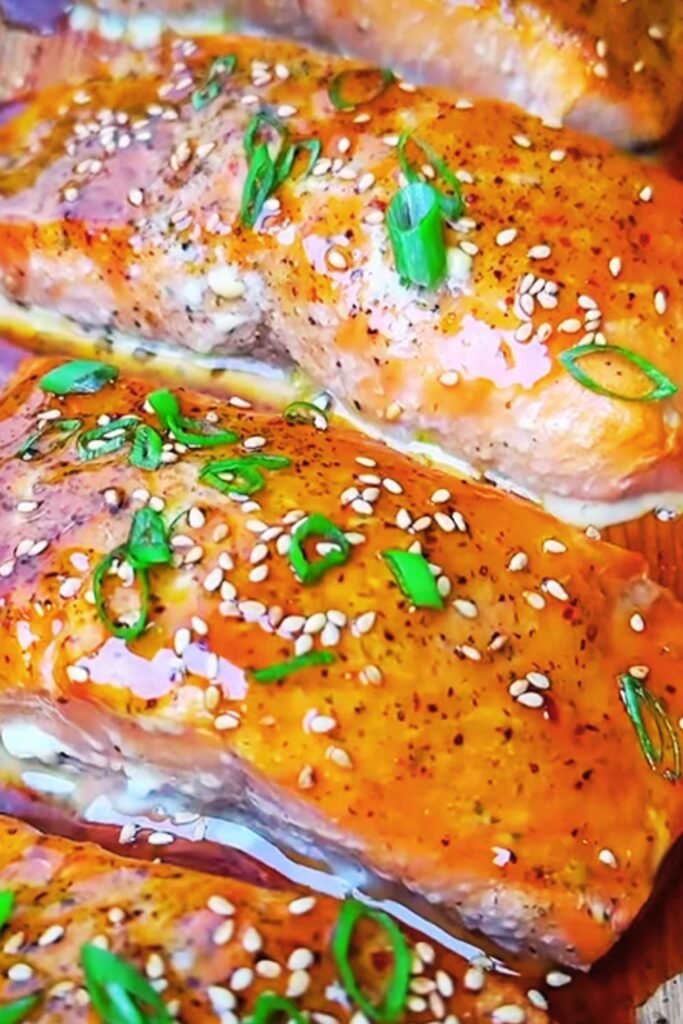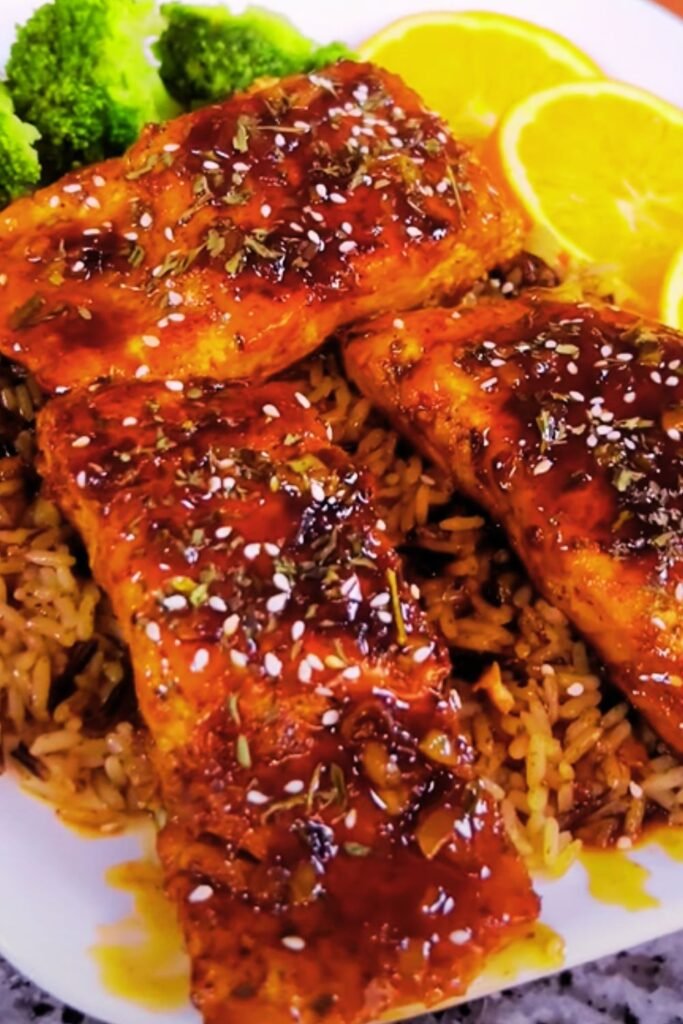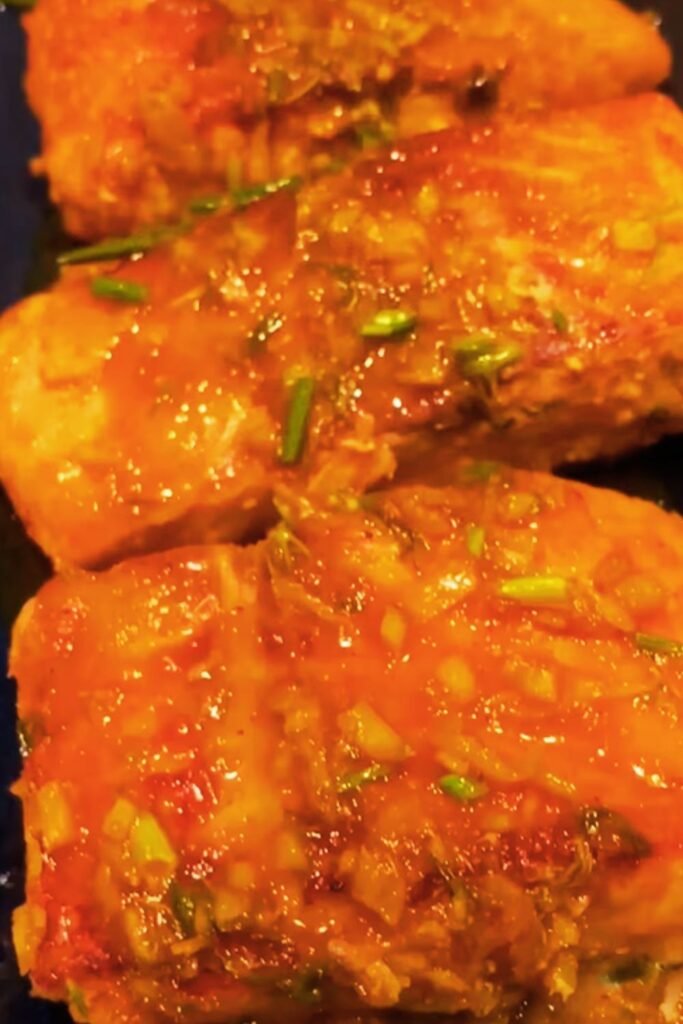There’s something magical about the combination of citrus and herbs that transforms a simple piece of salmon into a restaurant-quality masterpiece. I’ve been perfecting this orange glazed salmon recipe for years, and I can honestly say it’s become my go-to dish when I want to impress guests or treat my family to something special. The sweet-tangy orange glaze paired with aromatic rosemary creates a flavor profile that’s both sophisticated and comforting.
What makes this recipe truly special is how the natural oils from fresh rosemary infuse into the glaze, creating layers of flavor that complement the rich, buttery texture of the salmon. I’ve served this dish countless times, and it never fails to earn compliments. The best part? It’s surprisingly simple to make, requiring just a handful of ingredients and about 30 minutes from start to finish.
Understanding the Perfect Orange Glaze
The secret to an exceptional orange glaze lies in balancing sweetness, acidity, and aromatic herbs. I’ve experimented with various combinations over the years, and I’ve found that using fresh orange juice rather than bottled makes an enormous difference in both flavor and color.
Fresh Orange Juice: The natural sugars in fresh orange juice caramelize beautifully when reduced, creating a glossy, amber-colored glaze that clings perfectly to the salmon. I always use navel oranges or blood oranges when they’re in season for their superior flavor.
Honey vs. Sugar: While granulated sugar works, I prefer honey for its complex flavor profile and the way it helps the glaze adhere to the fish. Honey also adds subtle floral notes that complement the rosemary beautifully.
Rosemary Selection: Fresh rosemary is non-negotiable in this recipe. Dried rosemary simply doesn’t provide the same aromatic punch or visual appeal. I look for sprigs with vibrant green color and avoid any that appear woody or dried out.
Acid Balance: A touch of fresh lemon juice brightens the entire dish and prevents the glaze from becoming overly sweet. This small addition makes a significant difference in the final flavor profile.
Nutritional Benefits of This Power-Packed Dish
| Nutrient | Amount per Serving | % Daily Value | Health Benefits |
|---|---|---|---|
| Protein | 34g | 68% | Supports muscle development and repair |
| Omega-3 Fatty Acids | 1,200mg | 300% | Promotes heart and brain health |
| Vitamin C | 45mg | 50% | Boosts immune system, antioxidant properties |
| Selenium | 28mcg | 51% | Supports thyroid function and metabolism |
| Vitamin D | 360 IU | 90% | Essential for bone health and immune function |
| Potassium | 420mg | 12% | Regulates blood pressure and muscle function |
| Folate | 25mcg | 6% | Supports cell division and DNA synthesis |
This nutritional powerhouse provides exceptional value, delivering high-quality protein and essential fatty acids while remaining relatively low in calories. The addition of fresh herbs like rosemary contributes antioxidants and anti-inflammatory compounds.
Essential Ingredients and Their Roles

Primary Ingredients
Salmon Fillets (4 pieces, 6 oz each): I prefer skin-on fillets for their superior texture and flavor retention. The skin helps protect the delicate flesh during cooking and adds richness to the final dish.
Fresh Orange Juice (1 cup): The foundation of our glaze, providing natural sweetness and bright citrus flavor. I typically need 3-4 large oranges to yield sufficient juice.
Fresh Rosemary (3 sprigs): The aromatic star that elevates this dish from ordinary to extraordinary. I strip the leaves from the stems and chop them finely for even distribution.
Honey (1/4 cup): Creates the perfect consistency for our glaze while adding complex sweetness that complements the orange beautifully.
Fresh Lemon Juice (2 tablespoons): Balances the sweetness and adds brightness to prevent the glaze from becoming cloying.
Minced Garlic (3 cloves): Provides depth and savory notes that ground the citrus flavors.
Olive Oil (2 tablespoons): Used for searing the salmon and adding richness to the overall dish.
Seasoning and Finishing Touches
Sea Salt (1 teaspoon): Enhances all the flavors and helps the glaze adhere to the salmon.
Black Pepper (1/2 teaspoon): Adds subtle heat and complexity.
Orange Zest (1 tablespoon): Intensifies the citrus flavor and adds beautiful color contrast.
Fresh Thyme (1 teaspoon): Optional but recommended for additional herbal complexity.
Equipment and Preparation Requirements
| Equipment | Purpose | Alternative Options |
|---|---|---|
| Large Oven-Safe Skillet | Searing and baking salmon | Cast iron or stainless steel pan |
| Small Saucepan | Reducing glaze | Heavy-bottomed pot |
| Instant-Read Thermometer | Checking doneness | Visual cues (flaking) |
| Fine-Mesh Strainer | Straining glaze | Clean kitchen towel |
| Citrus Juicer | Extracting juice | Manual squeezing |
| Sharp Knife | Ingredient preparation | Well-maintained kitchen knife |
| Cutting Board | Prep surface | Stable work surface |
Step-by-Step Cooking Instructions
Preparing the Orange Glaze

I always start with the glaze because it needs time to reduce and develop its rich consistency. In a small saucepan, I combine the fresh orange juice, honey, minced garlic, and chopped rosemary. The key is maintaining a gentle simmer rather than a rolling boil, which can cause the honey to become bitter.
I bring the mixture to a gentle simmer over medium heat, then reduce the heat to low and let it cook for 15-20 minutes. During this time, I stir occasionally and watch for the mixture to reduce by about two-thirds. The glaze is ready when it coats the back of a spoon and has a beautiful amber color.
Once the glaze reaches the proper consistency, I strain it through a fine-mesh strainer to remove the rosemary bits and garlic pieces. This creates a smooth, glossy finish that looks professional and elegant. I then whisk in the lemon juice and orange zest, which I add at the end to preserve their bright flavors.
Preparing the Salmon
While the glaze reduces, I prepare the salmon fillets. I remove them from the refrigerator about 15 minutes before cooking to bring them closer to room temperature, which ensures even cooking. I pat each fillet completely dry with paper towels and season both sides generously with salt and pepper.
The key to perfect salmon is achieving a beautiful sear on the skin side while keeping the flesh moist and flaky. I heat my oven-safe skillet over medium-high heat and add the olive oil. When the oil shimmers but doesn’t smoke, I carefully place the salmon fillets skin-side down in the pan.
I resist the urge to move the fillets for the first 4-5 minutes, allowing the skin to develop a golden, crispy texture. The salmon will naturally release from the pan when it’s ready to flip. I then carefully turn each fillet and sear the flesh side for 2-3 minutes.
Glazing and Finishing

After searing both sides, I brush about half of the prepared glaze over the salmon fillets. The residual heat from the pan helps the glaze adhere and begin caramelizing immediately. I then transfer the skillet to a preheated 400°F oven for 6-8 minutes, depending on the thickness of the fillets.
I check for doneness using an instant-read thermometer, looking for an internal temperature of 145°F. However, I personally prefer my salmon slightly less done, around 135°F, as it continues cooking from residual heat and remains more moist.
During the last 2 minutes of cooking, I brush the remaining glaze over the salmon, creating multiple layers of flavor and a beautiful, glossy finish. The glaze should be bubbling and caramelizing around the edges of the fillets.
Cooking Time and Temperature Guide
| Fillet Thickness | Searing Time | Oven Time | Internal Temperature |
|---|---|---|---|
| 1 inch | 4-5 minutes per side | 6-8 minutes | 145°F (well-done) |
| 1.5 inches | 5-6 minutes per side | 8-10 minutes | 140°F (medium) |
| 2 inches | 6-7 minutes per side | 10-12 minutes | 135°F (medium-rare) |
Serving Suggestions and Pairings
The beauty of this orange glazed salmon lies in its versatility. I’ve served it with countless side dishes, and it adapts beautifully to various flavor profiles and cooking styles.
Vegetable Pairings
Roasted Asparagus: The earthy flavor of asparagus complements the citrus glaze perfectly. I often roast asparagus spears with olive oil, salt, and pepper alongside the salmon.
Garlic Mashed Potatoes: Creamy, buttery potatoes provide a comforting base that soaks up the delicious glaze. I add roasted garlic to my mashed potatoes for extra depth.
Quinoa Pilaf: For a healthier option, I serve the salmon over a bed of quinoa mixed with fresh herbs, toasted pine nuts, and dried cranberries.
Steamed Broccoli: Simple steamed broccoli with a squeeze of lemon juice allows the salmon to be the star while adding nutritional value.
Grain and Starch Options
Wild Rice: The nutty flavor of wild rice pairs beautifully with the orange and rosemary combination. I often cook it in vegetable broth for extra flavor.
Cauliflower Rice: For a low-carb option, cauliflower rice seasoned with herbs and a touch of butter works wonderfully.
Roasted Sweet Potatoes: The natural sweetness of roasted sweet potatoes complements the orange glaze while adding vibrant color to the plate.
Storage and Reheating Guidelines
| Storage Method | Duration | Quality Notes |
|---|---|---|
| Refrigerator | 2-3 days | Best quality within 24 hours |
| Freezer | 1-2 months | Texture may change slightly |
| Room Temperature | 2 hours maximum | Food safety consideration |
Proper Storage Techniques
I always allow the salmon to cool completely before storing it in the refrigerator. I place it in an airtight container or wrap it tightly in plastic wrap, ensuring the glaze doesn’t separate from the fish. When reheating, I prefer using the oven at 300°F for 10-15 minutes rather than the microwave, which can make the salmon tough.
Leftover Transformation Ideas
Leftover orange glazed salmon makes an excellent addition to salads, grain bowls, or pasta dishes. I often flake it into a warm quinoa salad with fresh vegetables and a light vinaigrette. It also works beautifully in salmon patties or as a topping for avocado toast.
Troubleshooting Common Issues
Glaze Too Thin
If my glaze doesn’t thicken properly, I continue simmering it on low heat until it reaches the right consistency. Sometimes I add a teaspoon of cornstarch mixed with water to help it thicken more quickly.
Salmon Overcooked
Overcooked salmon becomes dry and flaky in an unpleasant way. I’ve learned to err on the side of slightly underdone, as the fish continues cooking from residual heat after removal from the oven.
Burnt Glaze
If the glaze starts to burn during cooking, I immediately reduce the oven temperature and tent the salmon with foil. The sugars in the glaze can caramelize quickly, so monitoring is essential.
Seasonal Variations and Adaptations
Spring Adaptation
During spring, I sometimes add fresh dill or tarragon to the glaze for a lighter, more delicate flavor profile. Fresh peas or asparagus make excellent seasonal accompaniments.
Summer Variation
In summer, I might grill the salmon instead of oven-finishing it, brushing the glaze on during the last few minutes of cooking. Fresh corn and tomatoes make perfect summer sides.
Fall Enhancement
For fall, I sometimes add a touch of maple syrup to the glaze and serve it with roasted Brussels sprouts or butternut squash.
Winter Comfort
During winter months, I might add a pinch of cinnamon or nutmeg to the glaze and serve it with heartier sides like roasted root vegetables or wild rice stuffing.
Wine and Beverage Pairings
The bright, citrusy flavors of this dish pair beautifully with various beverages. I often serve it with a crisp white grape juice or sparkling apple cider for special occasions. The effervescence cuts through the richness of the salmon while complementing the orange flavors.
For non-alcoholic options, I love serving fresh-squeezed lemonade with a sprig of rosemary or orange-infused sparkling water. These beverages echo the citrus theme while cleansing the palate between bites.
Professional Tips for Perfect Results
After years of making this recipe, I’ve discovered several tricks that elevate the final dish:
Room Temperature Fish: Always bring salmon to room temperature before cooking. This ensures even cooking and prevents the outside from overcooking while the center remains cold.
Skin Scoring: I lightly score the skin in a crosshatch pattern before cooking, which prevents curling and ensures even contact with the pan.
Glaze Timing: I reserve about a third of the glaze for finishing, which maintains the bright orange color and fresh flavor that can be lost during cooking.
Resting Period: I always let the salmon rest for 2-3 minutes after removing it from the oven, allowing the juices to redistribute throughout the fish.
Q&A Section
Q. Can I use frozen salmon for this recipe? A. Yes, but make sure to thaw it completely and pat it very dry. Frozen salmon tends to release more moisture during cooking, which can affect the glaze adherence.
Q. How do I know when the salmon is perfectly cooked? A. The internal temperature should reach 145°F for food safety, but I prefer 135°F for a more moist texture. The flesh should flake easily with a fork but still appear slightly translucent in the center.
Q. Can I make the glaze ahead of time? A. Absolutely! I often make the glaze a day ahead and store it in the refrigerator. Just gently reheat it before using, and you may need to thin it slightly with orange juice.
Q. What if I don’t have fresh rosemary? A. While fresh rosemary is ideal, you can substitute with 1 teaspoon of dried rosemary. Add it early in the glaze-making process to allow it to rehydrate and release its flavors.
Q. Can I substitute the honey with another sweetener? A. Yes, maple syrup or agave nectar work well as substitutes. Brown sugar can also work, though it will create a slightly different flavor profile.
Q. How do I prevent the glaze from burning? A. Keep the oven temperature at 400°F or lower, and if you notice the glaze darkening too quickly, tent the salmon with foil for the remainder of the cooking time.
Q. Can I use this glaze on other types of fish? A. Definitely! This glaze works wonderfully on halibut, sea bass, or even chicken breasts. Adjust cooking times accordingly based on the protein’s thickness and cooking requirements.
Q. What’s the best way to get crispy skin? A. Start with completely dry salmon, use a hot pan with oil, and don’t move the fish until it naturally releases from the pan. This usually takes 4-5 minutes for the skin to become golden and crispy.
Q. Can I double this recipe for a larger group? A. Yes, the recipe scales well. Just make sure to use a large enough pan or cook in batches to avoid overcrowding, which can cause steaming instead of searing.
Q. How do I store leftover glaze? A. Store any leftover glaze in the refrigerator for up to a week. It’s delicious on roasted vegetables, grilled chicken, or even as a salad dressing when thinned with olive oil.
This orange glazed salmon with rosemary has become one of my signature dishes, and I’m confident it will become a favorite in your kitchen too. The combination of technique, quality ingredients, and attention to detail creates a restaurant-quality meal that’s surprisingly achievable at home. Whether you’re cooking for a special occasion or simply want to elevate a weeknight dinner, this recipe delivers impressive results every time.